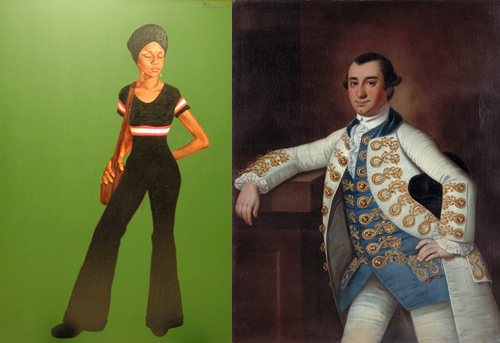
In conjunction with our Face Lift exhibition, we are launching a caption writing contest and we need your participation! Each week of the exhibition, curator Sara Arnold will present a set of images—as paired in the gallery—and we invite you to submit a clever comment on our blog that expresses your own interpretation of the comparison. The author of our favorite caption each week will receive a free admission pass to the Gibbes. At the end of the campaign, all winning captions will be entered in a drawing for a facial from The Spa at Charleston Place.
Read the full terms and conditions for the Face Lift: Caption This! contest.
Week One: Ms. Johnson (Estelle), 1972, by Barkley Hendricks (American, b. 1945) and Colonel Barnard Elliott, Jr., ca. 1766, by Jeremiah Theus (Swiss/American, 1716–1744). What do you think these two would say to one another at a cocktail party? Or if they met on the street today? Join in the fun and submit your caption by adding a comment below.
Curatorial Perspective
Pose and costume are key indicators of the sitter’s status and identity in portraiture. Analyzing these subtle details of dress and comportment can yield an even more complex reading of the painting and the message that the artist is trying to express in its execution. While the style of dress differs dramatically in these two works, similarities in the subjects’ poses show a similar strength of self-awareness in differing social and cultural climates.
Of Swiss birth, Jeremiah Theus arrived in Charleston in 1735 where he became a preeminent early painter in terms of both productivity and reputation. Known for his portraits of prosperous Charleston families, Theus worked in the limner tradition which emphasized the flat, linear, and above all decorative qualities of the subject. In this portrait of Colonel Barnard Elliott, every detail of the costume’s fabric and texture is exquisitely rendered. Viewed in conjunction with the background of the Classical columns and his assertive pose, Elliott’s costume serves as a declaration of his wealth and prominence in the community. Elliott was a member of the First Provincial Congress of South Carolina, a Lieutenant-Colonel in the American Revolution, as well as a successful owner of rice plantations.
Though Ms. Johnson does not appear to share the prosperity enjoyed by Colonel Elliott, her dress and pose also convey a message. This portrait is part of Hendricks’s “limited palette series” executed after a trip to the Uffizi Gallery in Florence, Italy. So taken by these artists’ use of draped clothing to reveal solidity of form and the volumes of the body, Hendricks translated these lessons into a contemporary style of painting. Ms. Johnson is set against a solid color, and her closely fitted, black outfit serves to boldly delineate her form against the flat background. From a cultural standpoint, this painting also makes a bold statement about the racial, cultural, and economic divides in America. Painted in the 1970s, Ms. Johnson’s confident pose exudes a challenge to the status quo and is an assertion of minority presence, whereas the pose of Colonel Elliot reinforces the dominance of the white landed gentry.
Published September 9, 2010

